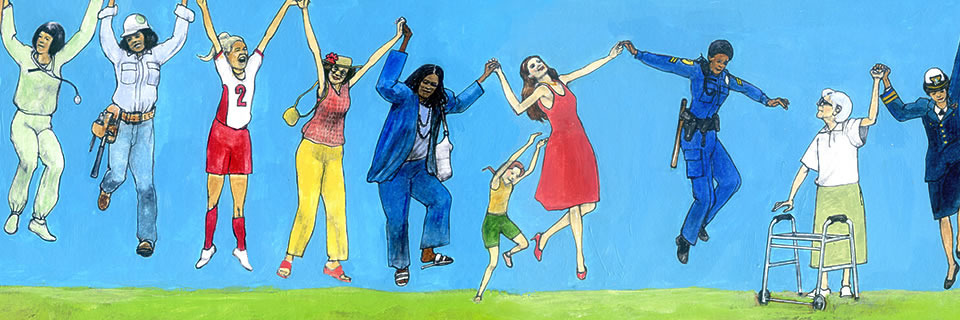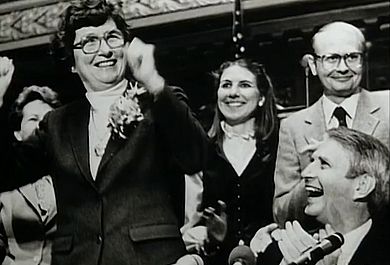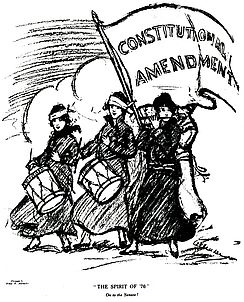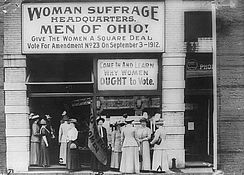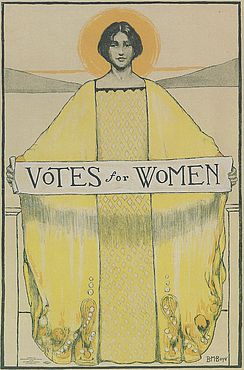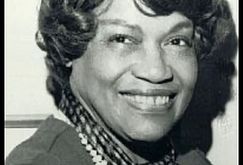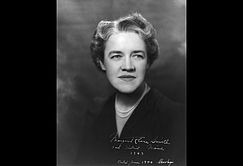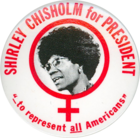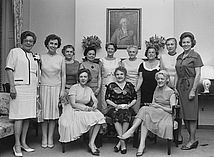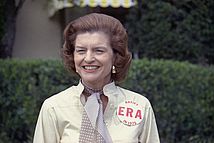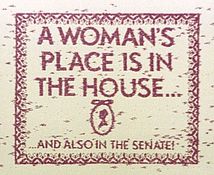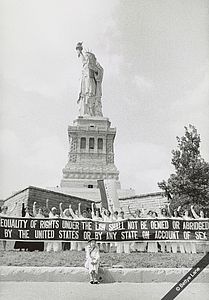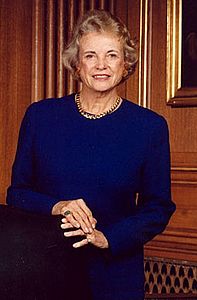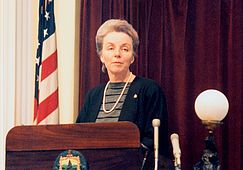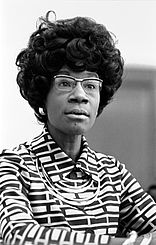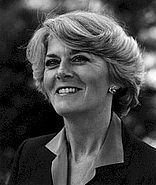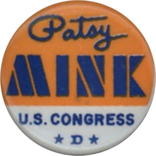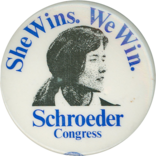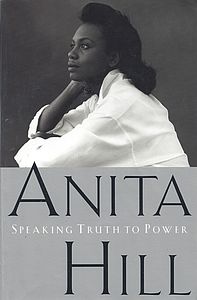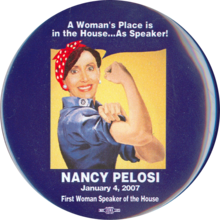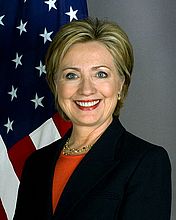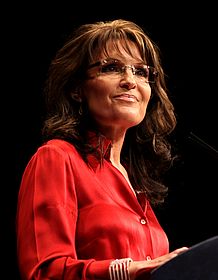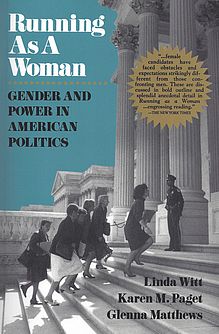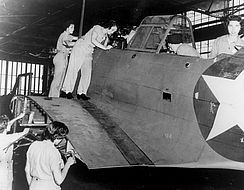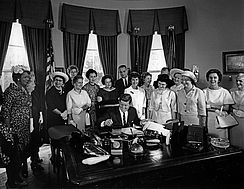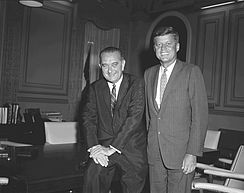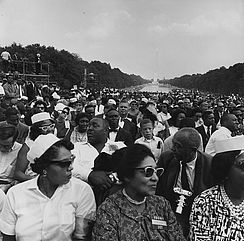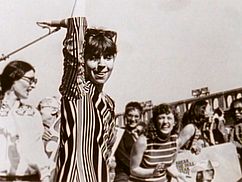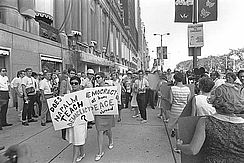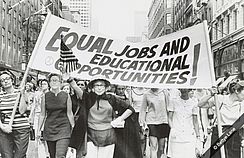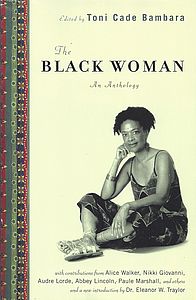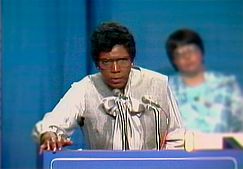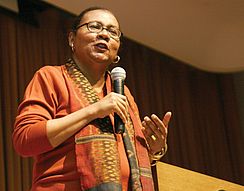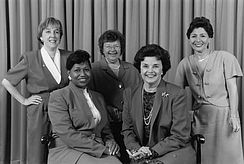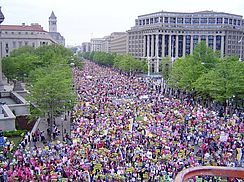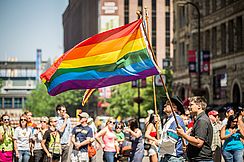Politics & Social Movements
Women in Politics: A Very Short History
Wisconsin’s Marital Property Reform Act was the first in the nation — thanks to Mary Lou Munts, the political powerhouse who made it happen.
Excerpt from “Step by Step: Building a Feminist Movement 1941-1977,” a film by Joyce Follet. (Running time 6:18) Used with permission. The complete film is available from Women Make Movies.
Women have long been involved in politics and public life, even before the Nineteenth Amendment gave them the vote in 1920, but women’s political activism took a giant leap forward starting in the 1960s. To be sure, we haven’t yet had a woman president, but at all other levels of American political life, women have crafted a strong and vibrant history. Some are public leaders and elected officials; others supply critical power behind the scenes.
For a long time, politics was defined very traditionally as voting, participating in organized political parties, and seeking elective office. In a key insight that spawned the field of women’s political history, feminist scholars realized that women had in fact played myriad roles in politics and public life over the entire course of American history, profoundly influencing social movements, civic life, and the provision of charity and social welfare, among other outcomes. How did they do this even before they got the vote? By forming voluntary organizations, lobbying, organizing petition drives, raising money, and participating in a range of activities that placed them in the thick of public life.
Women also have a strong history in partisan politics, one that — surprisingly, to some — predates the winning of suffrage in 1920. In 1870, women in Wyoming and Utah territories were the first to cast ballots in general elections. In other states, women won the right to vote in municipal elections or for school boards. Women also formed auxiliaries to the major political parties and joined third parties such as the Populist, Socialist, and Progressive parties.
The drive for woman suffrage, first enunciated at Seneca Falls in 1848, spanned seventy-two years and drew on three generations of female political activism. Especially in its final stages, it offered a single issue around which a broad constituency of women could coalesce. Conversely, when suffrage was won, that unity of purpose disappeared, and women scattered their political energy into a wide range of causes, not all specifically related to the advancement of women’s status.
What words drove Erma Henderson to become the most powerful woman of her time in Michigan politics?
Excerpt from “Passing the Torch,” a film by Carol King. (Running time 3:36) Used with permission. The complete film is available from King Rose Archives. For more information, visit Veteran Feminists of America.
There was no question that women were in politics to stay. Throughout the twentieth century, women did the grunt work of most political campaigns — ringing the doorbells, licking the envelopes, watching the polls — while men ran for office and headed the national party structures. Even though their contributions were undervalued many women were thrilled at the chance to take part in the political process. This growing sense of participatory inclusion was an important precondition for the breakthroughs of the last fifty years.
What year was Margaret Chase Smith nominated by a national party as the first woman in the United States to run for the presidency?
Excerpt from “The Life of Senator Margaret Chase Smith.” (Running time 5:52) Used with permission. The complete film is available from the Margaret Chase Smith Foundation.
While the majority of political candidates were men (and that is still true today), intrepid women did seek and win political office. One of the earliest ways for a woman to enter political life was through widow’s succession, an appointment to fill the term of her deceased husband. Some women merely served out a term, but others, such as Hattie Caraway of Arkansas and Margaret Chase Smith of Maine, used widow’s succession as a stepping-stone to launch political careers of their own. Smith, who for many years was the only woman in the U.S. Senate, even mounted a serious if ultimately symbolic run for the presidency as a Republican in 1964. Two U.S. Representatives, Shirley Chisholm of New York and Patsy Mink of Hawaii, followed Smith’s footsteps by entering the Democratic primaries in 1972. Mink was the first Asian American to run for president and Chisholm broke new ground as a female African American candidate.
Spurred in part by the revival of feminism in the 1960s and 1970s, more women sought — and won — elective office, although the numbers were still fairly small, especially on the national level. The National Women’s Political Caucus, founded in 1971, dedicated itself to increasing women’s participation at all levels of the political system. Women activists tried to influence party politics by working within the Democratic and Republican hierarchies, but found the major parties not always welcoming either to women activists or to the issues they brought to the table. Winning platform support for the Equal Rights Amendment and reproductive rights proved especially fractious, and Republican women who identified as feminists faced a challenging environment as the party shifted to the right from the 1970s onward. With a focus on electing women to Congress, Democratic women founded EMILY’s List (Early Money Is Like Yeast) in 1985 to promote pro-choice candidates, and in 1993 Republican women followed with the Susan B. Anthony List to support pro-life candidates. Another route to political power was through appointed office, with women serving in the Cabinet and diplomatic corps as early as the 1930s. Still, the Supreme Court remained all-male until the appointment of Sandra Day O’Connor in 1981.
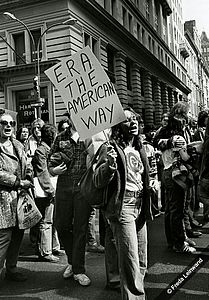
How is former Vermont Governor Madeleine Kunin continuing to help women enter politics?
Excerpt from “Madeleine May Kunin: Political Pioneer,” a film by Catherine E. C. Hughes. (Running time 4:15) Used with permission. The complete film is available from Vermont PBS.
Women politicians in the 1960s and 1970s served as important ambassadors for the expanding roles for women in American society, whether they were specifically feminist or not. Representatives like Bella Abzug (New York), Millicent Fenwick (New Jersey), Shirley Chisholm (New York), Patricia Schroeder (Colorado), and Patsy Mink (Hawaii) worked effectively to increase women’s visibility in politics; women governors such as Connecticut’s Ella Grasso and Vermont’s Madeleine Kunin demonstrated prowess on the state level.
An especially important milestone was Geraldine Ferraro’s selection as Walter Mondale’s running mate in the 1984 presidential campaign. She was the first woman nominated by a major party to its national ticket. The daughter of Italian immigrants who represented a heavily ethnic, working-class district in Queens, Ferraro energized many female voters; her presence on the Democratic ticket was widely interpreted as heralding a new era for women in national politics.
One factor behind Ferraro’s precedent-breaking selection was increased attention to women’s political clout at the polls, as represented by the newly christened gender gap, that is, the difference in men’s and women’s voting patterns. After decades of lagging behind, by 1980 women voted in the same proportion as men, which meant there were more female voters to court than ever before. Women also voted differently, especially on issues involving the use of force (such as war or foreign interventions) and social justice, a combination that tended to favor the Democrats. But on the other side of the gender gap, white men increasingly voted Republican. In a landslide election such as that of 1984, in which Ronald Reagan won 59 percent of the popular vote (including a majority of women’s votes), the gender gap was too small to function as an independent factor. Politicians have since learned that ignoring women’s votes is at their peril.
A new issue — sexual harassment — entered the political arena in 1991 and 1992. During the Senate confirmation hearings on the nomination of Clarence Thomas, a conservative black jurist, to the Supreme Court, Oklahoma law professor Anita Hill accused Thomas of having sexually harassed her when she worked at the Department of Education and the Equal Opportunity Employment Commission in the 1980s. Thomas vehemently denied the accusations, and the country split, not always strictly along race and gender lines, about who to believe. In the end, Thomas narrowly won confirmation and Hill became a feminist icon for her courage and grace under pressure.
Besides sparking a national debate on sexual harassment, the hearings fostered a widespread sense that Congress needed more women in seats of power. Angered at the treatment Hill received on Capitol Hill and in the national media, a record number of women ran for public office in 1992, with definite results: Women saw dramatic gains in both houses of Congress, as well as in state and local elections across the country. The “Year of the Woman” led to the “Decade of Women,” and twenty years later, many of those women had accumulated the necessary seniority to be major players in politics. Nancy Pelosi’s ascension to Speaker of the House of Representatives in 2007 made her the highest-ranking female politician in American history.
The 1992 election also introduced voters to a woman who would become one of the most respected but also one of the most deeply polarizing figures in recent American life: Hillary Rodham Clinton, the wife of presidential candidate Bill Clinton. Clearly not your traditional First Lady, Hillary Clinton took a leading role in her husband’s failed healthcare initiative and then stood by her man when the president was threatened with impeachment in 1998 for lying about his involvement with a young intern. Hillary Clinton weathered that storm, and, when her husband left office, she served in the U.S. Senator from New York and set her sights on the presidency of the United States.
n 2008, the Republican presidential candidate John McCain chose the Alaska governor Sarah Palin as his running mate. Palin’s charismatic public persona and conservative fiscal and social values resonated with Alaskan voters but she, like so many women candidates, had a hard time convincing the public that she had a legitimate claim to political authority. Hillary Rodham Clinton faced the same challenge in the Democratic primary. Many feminist rallied around her candidacy but many others were drawn to Barack Obama’s vision of hope and change for America. Gender and race played out in contentious — and not always predictable — ways in this race. After Obama won the Democratic primary and went on to win the presidency, he selected Hillary Rodham Clinton as his Secretary of State.
Eight years later, as Obama prepared to leave office, Hillary Rodham Clinton once again mounted a serious challenge for the presidency and won her bid to be the Democratic party’s candidate. However, 2016 would not be the year when the United States joined other countries from around the world in electing a female leader. Clinton won the popular vote but Republican candidate Donald Trump won in the Electoral College. In response to the election results, on the day after Trump’s inauguration, there was a Women’s March in Washington, about 400 sister marches in localities around the U.S., and marches in 80 other countries. These marches on January 21, 2017 constitute the largest one-day mass protest in the United States; estimates range from 2.5 to 5 million marchers.
In November 2020, as the country celebrated the 100th Anniversary of the Nineteenth Amendment and the 55th Anniversary of the Voting Rights Act, the Republican incumbent President Donald Trump was beaten at the polls and in the Electoral College by Democrat Joseph Biden and his running mate Senator Kamala Harris, the former Attorney General of California. Kamala Devi Harris, born in Oakland to a mother from India and a father from Jamaica, was the second African-American woman and first South Asian-American to serve in the U.S. Senate and is the first woman to be Vice President of the United States. In her victory speech, Harris stated: “While I may be the first woman in this office, I will not be the last, because every little girl watching tonight sees that this is a country of possibilities.”
Kamala Harris’s candidacy and her achievement demonstrate that, while the political climate has changed for the better for many women over the last fifty years, women in politics continue to be subjected to stereotypes and discrimination that obstruct gender equality. The challenge ahead is to harness and direct the energy seen in recent elections towards feminism’s goals of inclusion and social justice. Like so much else, women’s roles in public life are an unfinished revolution.
How to Navigate our Interactive Timeline
You will find unique content in each chapter’s timeline.
Place the cursor over the timeline to scroll up and down within the timeline itself. If you place the cursor anywhere else on the page, you can scroll up and down in the whole page – but the timeline won’t scroll.
To see what’s in the timeline beyond the top or bottom of the window, use the white “dragger” located on the right edge of the timeline. (It looks like a small white disk with an up-arrow and a down-arrow attached to it.) If you click on the dragger, you can move the whole timeline up or down, so you can see more of it. If the dragger won’t move any further, then you’ve reached one end of the timeline.
Click on one of the timeline entries and it will display a short description of the subject. It may also include an image, a video, or a link to more information within our website or on another website.
Our timelines are also available in our Resource Library in non-interactive format.
Timeline Legend
Yellow bars mark entries that appear in every chapter
This icon indicates a book
This icon indicates a film
1971 The Click! Moment
The idea of the “Click! moment” was coined by Jane O’Reilly. “The women in the group looked at her, looked at each other, and ... click! A moment of truth. The shock of recognition. Instant sisterhood... Those clicks are coming faster and faster. They were nearly audible last summer, which was a very angry summer for American women. Not redneck-angry from screaming because we are so frustrated and unfulfilled-angry, but clicking-things-into-place-angry, because we have suddenly and shockingly perceived the basic disorder in what has been believed to be the natural order of things.” Article, “The Housewife's Moment of Truth,” published in the first issue of Ms. Magazine and in New York Magazine. Republished in The Girl I Left Behind, by Jane O'Reilly (Macmillan, 1980). Jane O'Reilly papers, Schlesinger Library.

